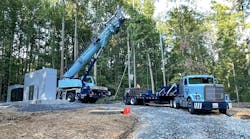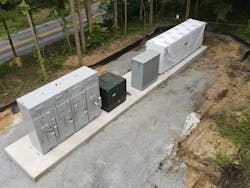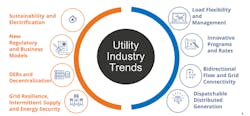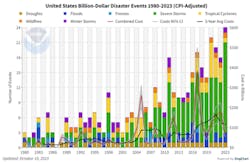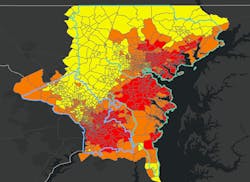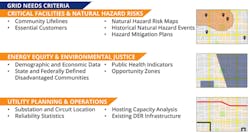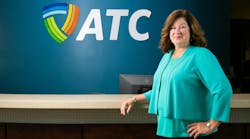The call for net-zero electric systems is clear within the current energy industry. Utilities are focused on restructuring their energy portfolios to help them meet their company, state and federal sustainability goals. 83% of U.S. customer accounts are served by a utility with a carbon-reduction target. A swift transition to a carbon-free system also requires utilities to focus on designing a climate-resilient grid while ensuring everyone reaps the benefits.
For SEPA, the primary macro drivers in the utility transition are decarbonization, electrification and decentralization. Utilities, however, have many opportunities afforded to them to address these forces, including load flexibility, innovative rate programs, bidirectional flow, and dispatchable distributed energy resources.
The data is definitive: as a consequence of significant greenhouse gas emissions, climate change is now progressing at a faster rate than at any other point in history. As a result, there has been a clear increase in the frequency and cost of extreme weather events in the U.S., and utilities are now developing
climate risk and adaptation plans.
Over the last 40 years, there has been a large upward trend in the frequency of and costs associated with severe weather. As weather events intensify, the resilience of our energy infrastructure becomes paramount. Utilities work tirelessly during these disasters and are increasingly focusing on powering critical facilities and prioritizing restoration. The key is ensuring this restoration happens swiftly, ensuring no community is left in the dark.
The question remains, how can utilities incorporate resilience and equity alongside the traditional tenets of electric power affordability, reliability and safety.
The Need for Resilience
The aftermath of these extreme weather events is not confined to the grid; it reverberates through communities. The ability of the grid and communities to withstand and adapt to these challenges defines their resilience. Each person possesses unique levels of exposure, sensitivity and adaptability, making their communities a tapestry of individual levels of resilience.
Exposure is defined as the characteristics of one’s environment and proximity to hazards. Increased exposure to factors such as high winds, extreme temperatures and severe storms increases the risk of damage to critical infrastructure and prolonged outages. Some communities are home to more sensitive populations and will have a difficult time dealing with damage and outages.
Sensitivity is defined as the degree to which people and places can be harmed. Populations that are dependent on power for medical and accessibility services are at risk of compromised health and safety, whereas less sensitive populations may only experience mild discomfort during an outage.
Adaptability refers to the capacity of a community or system to adjust to changing conditions. The resilience factor that utilities can control is adaptability. Utilities can improve the grid’s adaptability by deploying flexible and dispatchable distributed energy resources to communities, making them less vulnerable to grid stressors such as extreme weather events.
To better understand the resiliency status of the grid and the communities it serves, utilities and states across the country are collaborating with SEPA resilience experts.
SEPA’s Approach
SEPA’s mission champions the clean and smart transition of the energy system. The “S” in SEPA stands for “Smart,” which incorporates the core tenets of utility planning: affordability, reliability and safety. This means a clean energy transition, but not at all costs. The metrics of resilience and equity are integral to distribution system investments. The future of resilience doesn’t lie solely in traditional methods. Utilities must juxtapose traditional resilience investments, such as grid hardening and undergrounding, against non-traditional forays like solar PV projects and energy storage.
Building Resilience
Resilience is multifaceted. It is about the grid’s strength, the duration of extreme weather events, and the grid’s adaptability. Adaptive capabilities might encompass redundancy, localized generation, storage, distribution automation, and techniques for grid hardening.
This paints the picture of the resilience needs for a utility. SEPA and its utility partners are reimagining distribution system planning. This doesn’t mean compromising on affordability, reliability or safety. It’s about enhancing the planning process with the lenses of resilience and equity.
Every utility prioritizes essential customers, yet their definitions of “critical” can vary. After the COVID emergency, essential businesses like banks, grocery stores, and gas stations have taken center stage during emergencies. It is essential for utilities to continually re-evaluate and integrate varied perspectives on what is deemed critical.
As utilities have these conversations, state emergency management agencies, large energy users, local emergency planners, community-based organizations, consumer advocates and environmental advocates are all examples of organizations that should be at the table. Both in-person and virtual forums can be effective at collecting stakeholder input to make better informed decisions around “critical” and “essential” businesses. SEPA has also employed surveys as a mechanism allowing stakeholders to rank and prioritize the criticality of facility and facility types, and to collect data on these facilities.
Meeting Mandates
The rise in public utility commission (PUC) regulatory directives and state energy office funding for resilience investments within disadvantaged communities is noteworthy for utilities as grant recipients and/or partners. There is approximately $13.5 billion in funding from federal and state governments for enhanced grid resilience, with an emphasis on communities disproportionately impacted by climate change and power outages.
With the federal government mandating that 40% of all funding should flow to disadvantaged communities, utilities are grappling with this new layer. Hence, the importance of overlaying natural hazard risks with service boundaries and disadvantaged community data to pinpoint resilient zones for strategic investments.
The emphasis on resilience must also include a focus on societal equity.
With states beginning to increase support for disadvantaged communities, it is evident that not only is the federal government putting out these mandates for equity; states are focusing on these communities disproportionately impacted by climate change power outages. Drawing from SEPA’s hands-on experience, utility partners in Maryland, Virginia and Pennsylvania are beginning to look at how this data is overlaid in their own communities.
The journey towards a resilient and carbon free grid is not without challenges. Yet, with the emergence of technology such as longer-duration energy storage, the path is becoming clearer. Utilities can leverage these types of grid assets and customer assets for virtual power plants, delivering solutions that are both sustainable and resilient.
Approach in Practice
In the ever-evolving utility planning landscape, access to accurate and intuitive tools can make the difference between a project’s success or failure. As the energy sector charts its course towards a carbon-free system, the onus is on utilities to ensure that the transition is not only swift and sustainable but also equitable and resilient. SEPA’s process and approach, or our toolkit as we call it, offers a fresh perspective compared to traditional resilience studies.
- Focus: While traditional studies recommend specific suites of projects, SEPA identifies locations ripe for resilience opportunities.
- Scope: SEPA’s study is technology agnostic and primarily evaluates non-wires solutions such as energy storage, solar PV, and microgrid projects, whereas traditional studies zero in on wires solutions.
- Equity: A defining feature of SEPA’s approach is its incorporation of state and federally defined environ-mental justice and disadvantaged communities, a facet often overlooked in conventional studies.
- Granularity: SEPA’s approach goes beyond utility infrastructure, integrating critical customers and facilities, and prioritizes locations and potential opportunities for customer-sited, circuit-level, and/or substation-level solutions.
BGE partnered with SEPA to explore this approach. This partnership wasn’t solely focused on pinpointing resilience investment opportunities; it’s reimaging traditional planning efforts to pilot new processes.
This approach re-imagines the same process with new data layers, not excluding any important key values or key core tenets like affordability, safety and reliability. BGE is committed to continuing improvements that will enhance reliability, safety and resilience of the electric and natural gas system serving 1.3 million electric customers and 700,000 natural gas customers in central Maryland. As part of the utilities’ commitment to these principles, this partnership has leveraged this toolkit to make informed decisions prioritizing the needs of disadvantaged communities, as well as laying the foundation for the infrastructure work necessary for the State of Maryland to be able to meet its net-zero emissions by 2045 goal. This exercise has shed light on areas that require attention by providing a roadmap for actionable steps.
Making Informed Decisions
This toolkit’s efficacy was evident when BGE was faced with prioritizing potential sites for federal funding opportunities.
With six sites to choose from, the tool helped BGE select the most disadvantaged and impactful location for a resiliency project. The tool directed BGE to an area bordering two disadvantaged communities in a climate floodplain. This underscored the toolkit’s potential to house everything in one place, streamline and deepen the impact of processes. The tool illustrated how quickly the utility could pinpoint locations for resiliency projects, saving countless hours.
Broadening Horizons
BGE’s collaboration with SEPA and the use of their toolkit is facilitating in-house projects and paving the way for external collaborations. Currently, BGE is collaborating with organizations on similar partnerships for resilience hubs and energy storage projects. The utility is piloting the tool to confirm its effectiveness and is confident in its potential to quickly identify key issues. The toolkit’s potential extends beyond mere infrastructure planning. It plays a pivotal role in identifying customers disproportionately impacted by climate events enabling utilities take preventive measures.
The Road Ahead
Resilience is intertwined with every facet of the clean energy transition, from electrification to storage. Emerging technologies are key in this transition. Effective policies and stakeholder collaboration will be pivotal in achieving a carbon-free future.
The partnership between BGE and SEPA epitomizes the transformative power of collaboration and innovation. As the energy sector evolves, tools like the SEPA toolkit can be instrumental in ensuring that the transition is sustainable, resilient and equitable.
Ethan Holmes ([email protected]) is principal strategy analyst with Baltimore Gas & Electric. Prior to this role, he served as an analyst for Pepco Holdings as well as the Edison Electric Institute. He has worked in climate and energy policy since 1997, with experience in RTO/ISO and transmission policy, electric distribution policy, managing undergrounding and battery storage projects, distribution system planning policy, designing grid modernization policy and projects, grant writing, and leading stakeholder engagement on energy issues. He has a degree in economics from The George Washington University.
Jared Leader ([email protected]) is senior director of resilience at SEPA. In his role, he facilitates utilities, industry, regulators, legislators, customers, and other energy stakeholders toward a carbon-free and resilient energy future. Prior to joining SEPA, he spent several years working for utility, municipal and industry stakeholders in the energy and water sectors. He has a MS, Energy Policy and Climate from Johns Hopkins University, and a BS in Civil and Environmental Engineering from the University of Virginia. In 2021, Jared was recognized by PUF’s Fortnightly Under Forty list of energy and utility professionals.
